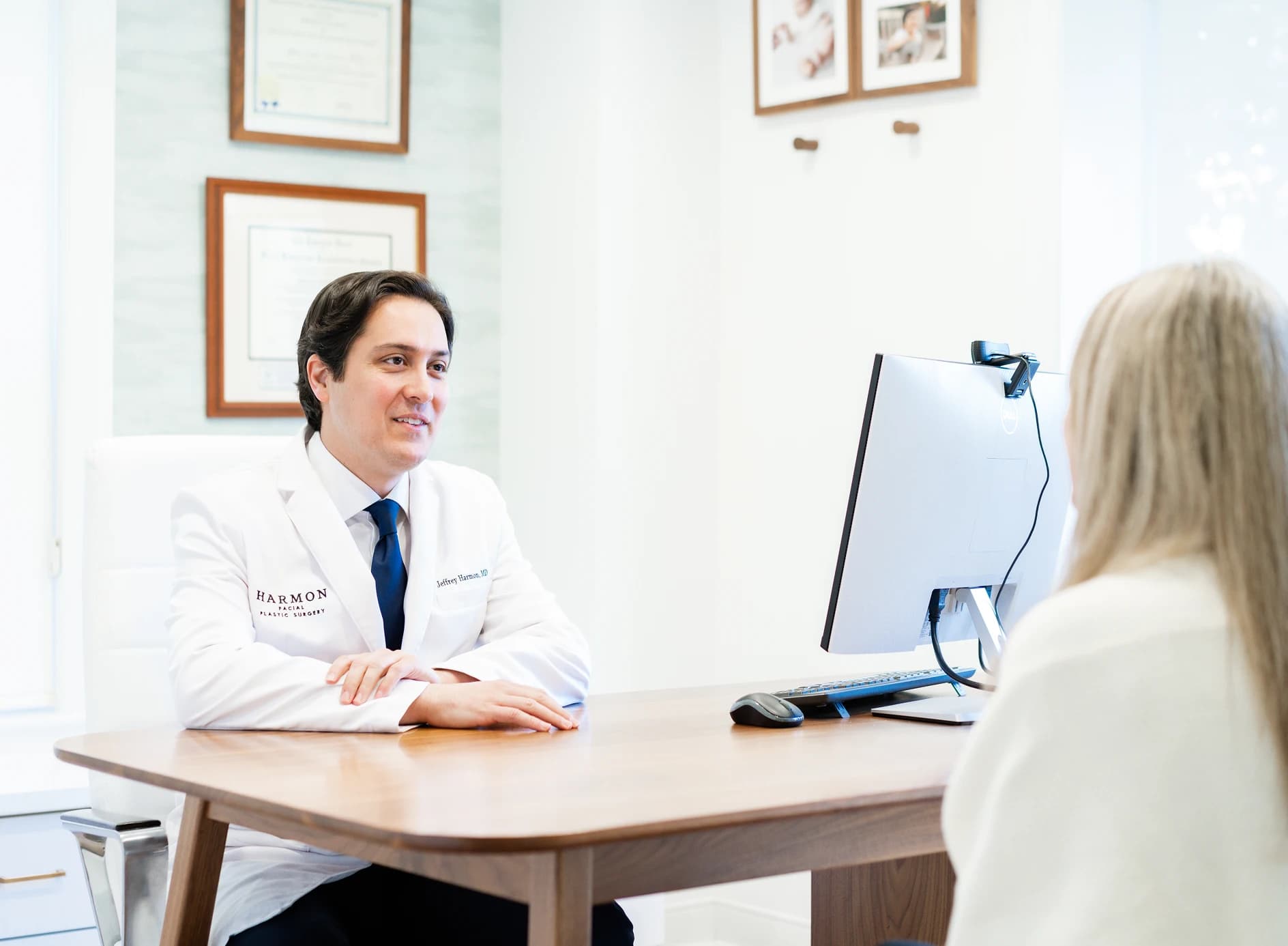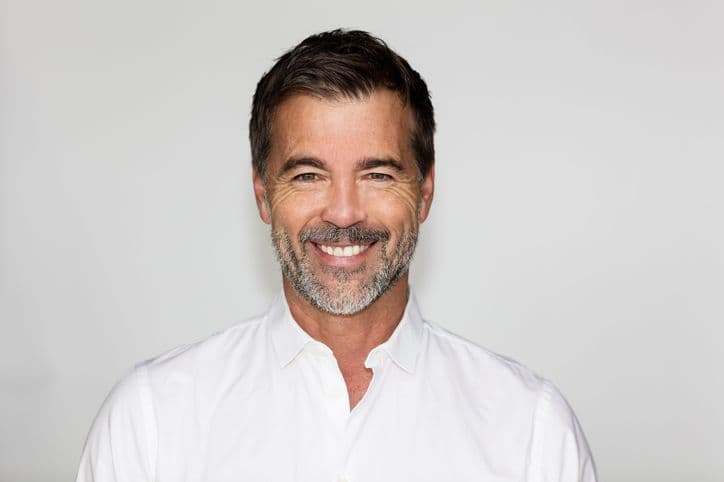Hair Restoration
- Can treat hair loss in patients who wear their hair short or long
- Can treat hair loss in male and female patients
- Can be performed with a combination of local and oral anesthesia
- Is a more permanent treatment option than medications and platelet-rich-plasma alone
Contact Us
What is Hair Restoration?
Hair restoration is a surgical procedure that helps increase the density of hair in areas where it has been lost. Follicular units, the smallest known unit of transferable hair, are removed from the back and side of the scalp and placed on the top of the scalp. Follicular units are composed of one (1) to four (4) hairs as well as the support structures that help hair survive and grow. Hair on the back (occipital) and side (parietal) of the scalp tends to be resistant to hormonal changes that lead to hair loss. They remain resistant to these hormonal changes when they are transferred to areas of the scalp where hair has been lost, also known as the recipient sites. The distribution of hair transferred to the recipient site(s) respond(s) to the pattern and extent of hair loss as well anticipated future hair loss. Careful placement of these microscopic follicular units creates natural-appearing results.
What Conditions Does the Procedure Address?
Hair restoration helps address conditions that lead to hair loss. The most common conditions hair restoration helps address are male pattern hair loss and female pattern hair loss, both of which are referred to as androgenic alopecia. Hair restoration also helps address hair loss in areas of scarring from previous trauma. Hair restoration cannot, however, address hair loss secondary to inflammatory, infectious, and behavioral causes.
Before & After
Explore our galleries to see the stunning, natural results Dr. Harmon delivers.
Why Choose Dr. Harmon
The desire for youthfulness is understandable. There is no area more important than the face. After all, the face cannot be hidden. It is how we present ourselves to the world. Dr. Harmon works with a refined eye and trained hands to develop a personalized treatment plan with you, utilizing advanced techniques in surgical and non-surgical care of the face, nose, eyes, neck and hair.
Fellowship trained facial plastic surgeons have a unique specialized skill set in performing surgical and non-surgical procedures on the face, nose, eyes, neck and hair. The pathway to becoming a facial plastic surgeon begins with five years of rigorous training in head and neck surgery. This training is focused on all aspects of surgery for the head and neck, in addition to aesthetic and reconstructive procedures.
A small pool of top performing graduates from head and neck surgery programs are then selected to complete sub-specialty training as a fellow in facial plastic and reconstructive surgery through the American Academy of Facial Plastic and Reconstructive Surgery (AAFPRS).
Dr. Harmon completed his fellowship in facial plastic surgery through the AAFPRS with the world-renowned facial plastic surgeon Dr. Andrew Jacono on Park Avenue in New York City. Dr. Jacono is world renowned for developing the extended deep plane facelift technique. Dr. Harmon is one of the few surgeons in the world, and the only surgeon in the Cincinnati area, fellowship trained in this technique by Dr. Jacono.
Quad A Accredited Surgery Suite
Harmon Facial Plastic Surgery is proud to have a Quad A accredited operating room and facility in our office. Our single-physician, single-specialty facility meets or exceeds the strict guidelines and high standards set forth by Quad A, demonstrating our strong commitment to patient safety and excellence in surgical care. We utilize the services of board-certified anesthesiology physicians only as well as our own personal clinical support staff to ensure the most comfortable, safest experience for our clients.
Types of Hair Restoration Procedures
There are two types of hair restoration surgery procedures, the follicular strip (FUT) procedure and the follicular unit extraction (FUE) procedure. Each approach differs primarily in the method in which follicular units are removed from the scalp. The method of creating the recipient sites for these follicular units in areas of hair loss and the method of transferring the follicular units to the recipient sites is the same between the FUT procedure and the FUE procedure.
Follicular Strip (FUT)
A thin strip of hair is removed from the scalp surgically. The tissue above and below this strip is then meticulously approximated using multiple layers of sutures. Hair at the upper and lower portion of the closure is not shaved. As a result, hair generally covers this incision while it heals. Hair technicians then carefully separate each follicular unit under the microscope in preparation for transfer.
Follicular Unit Extraction (FUE)
A specialized device like a rotating drill with a hollow core is used to extract individual follicular units across the scalp. The surgeon extracts follicular units broadly and consistently to minimize the appearance of hair loss in the areas of removal. The hair is shaved across a wider area than with a follicular strip (FUT) procedure. Hair technicians then organize each follicular unit under the microscope in preparation for transfer.
Overview of the Procedure
The team at Harmon Facial Plastic Surgery works tirelessly to prepare patients well for their procedure. The time spent with patients and resources provided facilitates a smooth transition from the procedure through recovery. The following overview is a broad summary of the information provided to patients:
Procedure Consultation
Expect a detailed, informative discussion with Dr. Harmon about your concerns and aesthetic goals. He will develop a personalized treatment plan to address these concerns and goals.
Pre-Treatment Preparation
Patients receive a packet with detailed pre-operative instructions prior to surgery. This packet includes information on what supplements and medications to hold prior to surgery, activity restrictions, and what supplies are necessary for post-operative recovery. Prescriptions are sent prior to surgery with instructions on their use. Finally, if medical clearance is required, a form detailing the necessary clearance and testing is provided to present to their primary care provider.
Day of Treatment
Patients are instructed to arrive at the office in comfortable clothes. The surgical plan is discussed with the patient in detail. Paperwork is completed. Photos are usually taken pre-operatively. Finally, the patient meets the surgical team, which may include nurses, anesthesiologists, scrub technologists, and/or hair technicians, depending on the procedure(s) and type of anesthesia used. Patients start their day in the operating room where the follicles are removed. They then transition to a room where the recipient sites are made for the transfer of these follicles. The technicians are preserving and organizing the follicles during the creation of the recipient sites. The surgeon discusses the design of the recipient sites with the hair technicians. Finally, the hair technicians place the hair follicles in the recipient sites as guided by the surgeon. Patients receive medications to anesthetize the scalp and for relaxation during the entirety of the procedure.
Follow-Up Appointment
Patients usually follow up at approximately seven (7) days after surgery. The patient’s sutures will be removed at this follow up appointment if they underwent a follicular strip (FUT) procedure. Patients then follow up at approximately three (3) months and one (1) year after surgery to monitor hair growth and overall healing.
Social Readiness
Many patients feel ready to socialize approximately one (1) to two (2) weeks after surgery. Patients are allowed to wear a hat covering the treatment sites starting approximately two (2) days after surgery. The time to resolution of bruising and swelling varies and depends on multiple patient-specific factors. The follicular strip (FUT) incision can take months to heal completely, though the incision is covered by hair growing from the top and bottom edge of the closure line. Scabs on the scalp are normal and can be present for approximately one (1) to two (2) weeks.
Ideal Candidates for Hair Restoration
Ideal candidates for hair restoration include patients who:
- Are experiencing male pattern or female pattern hair loss secondary to androgenic alopecia
- Are experiencing hair loss secondary to scarring from trauma
- Feel their pattern of hair loss makes them look older and less vital
Most candidates for hair restoration range in age from thirties (30s) to seventies (70s). A consultation is essential to determine candidacy for the procedure, because there may be factors that preclude this procedure for certain individuals. For example, a patient in their twenties (20s) may not be a good candidate for hair restoration because their pattern of future hair loss is less predictable. Also, a patient may be experiencing hair loss secondary to inflammatory, infectious, or behavioral causes for which hair restoration is not an appropriate treatment. Finally, a patient may be experiencing a vitamin deficiency or poorly functioning thyroid that, if treated, would result in renewed hair growth. Reasonable expectations must be established about what hair restoration can and cannot accomplish as with all plastic surgery procedures. As with all facial plastic surgery procedures, results can vary.
Benefits of Hair Restoration
Hair Restoration helps address hair loss. The procedure can help:
- Improve the thickness of hair in areas of hair loss
- Define a hairline that has been lost
- Reduce the depth of receding temples
- Fill in the crown that can form a spot devoid of hair
- Reduce the appearance of scarring with associated hair loss on the scalp
Risks of Hair Restoration
The risks of hair restoration include, but are not limited to:
- Bruising
- Swelling
- Infection
- Abnormal scarring
- Nerve damage
- Partial/incomplete growth of transferred hair follicles
Combine Hair Restoration with Other Facial Enhancements
Hair restoration can be combined with almost any facial enhancement to great effect. It can also be combined with other non-surgical procedures that help with hair growth.
Deep Plane Facelift
When combined with FUE or FUT hair restoration, a deep plane facelift may enhance facial contours while a restored hairline helps frame the face for a comprehensive, rejuvenated appearance.
Brow Lift
A brow lift can elevate the upper face and may complement the refreshed hairline created through FUE or FUT by enhancing balance and restoring a youthful, lifted expression.
Blepharoplasty
While hair restoration helps improve the upper facial frame, blepharoplasty may brighten and open the eyes. This comprehensive pairing can help reflect a vibrant, rested look.
Laser Skin Resurfacing
FUE and FUT help restore hair density, and laser skin resurfacing refines skin tone and texture. When paired, they may refresh the face from scalp to skin for a more youthful overall appearance.
Botox©
Botox© smooth dynamic lines in the brow and forehead and may subtly enhance the revitalized appearance of the upper face following FUE or FUT hair restoration.
Platelet-Rich Plasma (PRP) Scalp Treatment
PRP therapy is often used alongside FUE or FUT to nourish follicles and accelerate healing. This regenerative boost can support thicker, healthier hair growth and may optimize long-term results.

Book Your Consultation
Take the first step toward your aesthetic goals with a personalized consultation. Dr. Harmon will listen to your concerns, answer your questions, and guide you through your options. Schedule your consultation today and discover how expert care can make a difference.
Read More About Hair Restoration

Hair Loss Treatments: An Explainer
Hair loss treatments can address specific concerns about the appearance of the hair on your scalp due to a condition called androgenic alopecia....

How are Hair Follicles Kept Alive Prior to Transplantation?
Follicular units, which are composed of one or more hair follicles (usually up to four) and important support structures for the hair generating...

What Medical Conditions Leading to Hair Loss Would Not be Appropriate for Hair Restoration Surgery?
Hair restoration surgery, which includes follicular strip (FUS) and follicular unit extraction (FUE) procedures, is an excellent option to treat the...
FAQ
What type of anesthesia is required?
Hair restoration surgery is generally performed with a combination of local anesthesia and oral medications to help patients relax.
Can my original hairline be restored with hair restoration surgery?
An individual's original hairline usually cannot be restored with hair restoration surgery unless they have experienced only minimal recession of their hairline. The benefits of improving the definition of the hairline and improving the density of the hair at the top of the head are significant. However, the number of hair follicles required to push a hairline forward is so immense that there are usually insufficient hair follicles available to transplant to restore the hairline and improve density behind it in a natural way. A frank, detailed discussion with your surgeon is essential to understand the results achievable with hair restoration surgery. A skilled, fellowship-trained facial plastic surgeon such as Dr. Jeffrey Harmon can provide a natural hairline result that fits the individual's face.
Is FUE scarless?
Neither FUT nor FUE are entirely scarless. All surgical procedures result in a scar. Creating a surgical site that is minimally visible with FUT involves careful surgical closure and wound care such that the incision can easily hide under the surrounding hair. Creating a surgical site that is minimally visible with FUE involves properly spacing the extracted sites diffusely and randomly throughout the donor site such that they become unrecognizable.
Can hair restoration surgery be completed with one procedure or does it require multiple sessions?
The plan for hair restoration surgery depends on the aesthetic goals of the individual and the limits inherent in their anatomy and past medical history. Hair restoration surgery often requires more than one session, because transplanting too many hair follicles at once can compromise healing. Also, allowing a portion of the transplanted hair to grow allows adjustments to be made based on the appearance of the previously transplanted hair. This approach can maximize the final results.
How long does it take to notice results from hair restoration surgery?
The transplanted hair follicles initially shed their hairs within a few weeks of the procedure. This occurs with all hair transplant procedures and does not indicate failure of the procedure. The hair follicles then regrow over the ensuing few months. As a result, it can take 6 to 12 months to identify the expected final results.
Is hair restoration surgery permanent?
The hair that is transplanted to the areas of the scalp where hair is lost tend to be resistant to the hormonal changes that cause the hair loss in those areas. Therefore, while those transplanted hair follicles that grow are expected to remain with age, those hair follicles which are native to the area remain sensitive to hair loss signals and can continue to be lost over time. Hair restoration surgery seeks to predict the most likely pattern of continued hair loss and hedge against it with the transplantation of hair follicles.
Is hair restoration surgery a common surgical procedure?
Yes, hair restoration surgery is a common surgical procedure. The International Society of Hair Restoration Surgery (ISHRS) releases data annually about practice patterns in hair restoration surgery around the world. The ISHRS reported 149,254 hair restoration surgery procedures were perfomed in the United States/Canada in 2021, a 36% increase from 2010.
Can anyone with hair loss benefit from hair restoration surgery?
While many individuals could benefit from hair restoration surgery, a detailed medical history and thorough physical exam are required to determine an individual's candidacy. This is because there are some medical conditions for which hair restoration surgery would not be appropriate. Some individuals may even require evaluation by a dermatologist and a skin biopsy to rule out nutritional, autoimmune, or infectious causes of hair loss. Also, some younger individuals may not be candidates for hair restoration surgery when their final pattern of hair loss is unpredictable.
Is it best to understand hair restoration surgery by the machine used?
There are many devices marketed for hair restoration procedures. Most are devices used for FUE. FUE is not always the most appropriate approach for hair restoration surgery. Also, the machine used cannot replace the medical judgement necessary to decide whether someone is a good candidate for surgery or the surgical judgement necessary to determine how to harvest hair and where to place the hair follicles in the areas of hair loss. Seek a provider trained in a range of approaches to hair restoration surgery who can make appropriate recommendations for you. Dr. Jeffrey Harmon is a fellowship-trained facial plastic surgeon trained in the range of approaches to hair restoration surgery.
Can medical treatment complement hair restoration surgery?
Medical treatment is an essential adjunct to hair restoration surgery. For example, there are some nutritional supplements that can be helpful in preserving hair. Topical minoxidil and oral finasteride are both long-used medications that can preserve and regrow hair while in use. Finally, hair loss treatments can be used during and independent of hair restoration surgery to help preserve and regrow hair. The most appropriate approach to medical treatment requires consultation with your treating physician.
How do non-surgical hair loss treatments compare with hair restoration surgery?
Non-surgical hair loss treatments can serve as an adjunct to hair restoration surgery intra-operatively to improve the health and growth of transplanted hair follicles. However, these treatments alone, while effective in improving thickness and coverage of hair, are not as effective as hair restoration surgery. This is because hair restoration surgery can replace growing hair follicles in areas where they are not currently. The decision about whether to receive non-surgical hair loss treatments to the scalp only versus hair restoration surgery with these treatments depends on a detailed conversation with Dr. Harmon.
Is hair restoration surgery a painful procedure?
Facial plastic surgery procedures are generally well-tolerated by patients and typically involve little pain, especially when compared with surgery on other areas of the body. Patients are usually prescribed just a small amount of pain medication for after surgery. In fact, we have found most use only over-the-counter pain medication including acetaminophen and/or ibuprofen after surgery instead. And those who do use the prescribed pain medication usually only use it the first night after surgery. With that in mind, it is important to note that every patient perceives and processes pain differently. Some patients have a high pain tolerance. Others may be more predisposed to be more sensitive to pain. We at Harmon Facial Plastic Surgery are focused on balancing minimizing post-operative discomfort and maximizing safety.
Written by Dr. Harmon
Discover the expertise and compassionate care of Dr. Jeff Harmon, a fellowship-trained facial plastic surgeon deeply rooted in the Cincinnati community. A former collegiate athlete and Cornell University graduate, Dr. Harmon brings discipline, precision, and a global perspective to his surgical practice—refined through elite fellowship training in New York City.
Located in Hyde Park, Harmon Facial Plastic Surgery proudly serves patients throughout the Cincinnati area offering personalized facial aesthetics with world-class skill and a hometown heart.